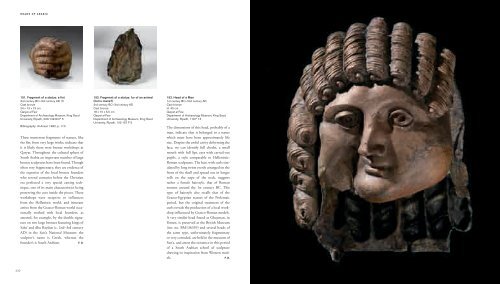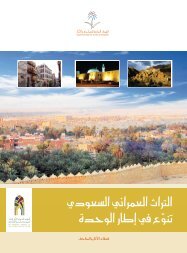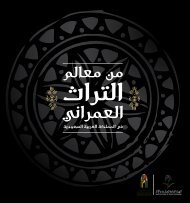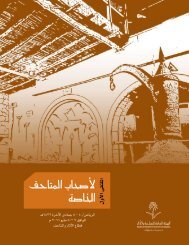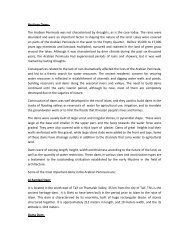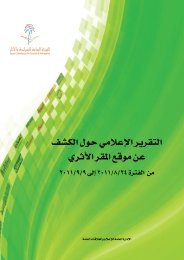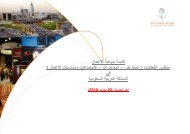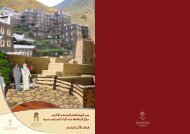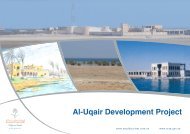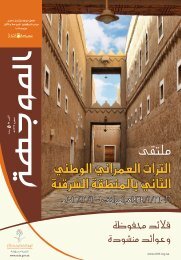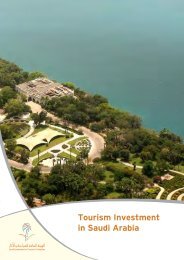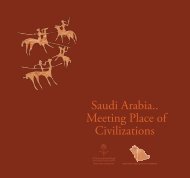Roads of Arabia
Roads of Arabia
Roads of Arabia
Create successful ePaper yourself
Turn your PDF publications into a flip-book with our unique Google optimized e-Paper software.
18bis Arabie US p318-363.qxd 23/06/10 22:12 Page 332<br />
ROADS OF ARABIA<br />
151. Fragment <strong>of</strong> a statue: a fist<br />
3rd century BC–3rd century AD (?)<br />
Cast bronze<br />
24 x 13 x 13 cm<br />
Qaryat al-Faw<br />
Department <strong>of</strong> Archaeology Museum, King Saud<br />
University, Riyadh, 240/149-84 F 5<br />
Bibliography: Al-Ansari 1982, p. 110.<br />
These numerous fragments <strong>of</strong> statues, like<br />
the fist, from very large works, indicate that<br />
it is likely there were bronze workshops at<br />
Qaryat. Throughout the cultural sphere <strong>of</strong><br />
South <strong>Arabia</strong> an important number <strong>of</strong> large<br />
bronze sculptures have been found. Though<br />
<strong>of</strong>ten very fragmentary, they are evidence <strong>of</strong><br />
the expertise <strong>of</strong> the local bronze founders<br />
who several centuries before the Christian<br />
era perfected a very special casting technique,<br />
one <strong>of</strong> its main characteristics being<br />
preserving the core inside the pieces. These<br />
workshops were receptive to influences<br />
from the Hellenistic world, and itinerant<br />
artists from the Graeco-Roman world occasionally<br />
worked with local founders, as<br />
attested, for example, by the double signature<br />
on two large bronzes featuring kings <strong>of</strong><br />
Saba’ and dhu Raydan (c. 2nd–3rd century<br />
AD) in the San‘a National Museum: the<br />
sculptor’s name is Greek, whereas the<br />
founder’s is South <strong>Arabia</strong>n. F. D.<br />
152. Fragment <strong>of</strong> a statue: fur <strong>of</strong> an animal<br />
(lion’s mane?)<br />
3rd century BC–3rd century AD<br />
Cast bronze<br />
18 x 10 x 5.5 cm<br />
Qaryat al-Faw<br />
Department <strong>of</strong> Archaeology Museum, King Saud<br />
University, Riyadh, 102-157 F 5<br />
153. Head <strong>of</strong> a Man<br />
1st century BC–2nd century AD<br />
Cast bronze<br />
H. 40 cm<br />
Qaryat al-Faw<br />
Department <strong>of</strong> Archaeology Museum, King Saud<br />
University, Riyadh, 119 F 13<br />
The dimensions <strong>of</strong> this head, probably <strong>of</strong> a<br />
man, indicate that it belonged to a statue<br />
which must have been approximately life<br />
size. Despite the awful cavity deforming the<br />
face, we can identify full cheeks, a small<br />
mouth with full lips, eyes with carved-out<br />
pupils, a style comparable to Hellenistic-<br />
Roman sculptures. The hair, with curls simulated<br />
by long twists evenly arranged on the<br />
front <strong>of</strong> the skull and spread out in longer<br />
rolls on the nape <strong>of</strong> the neck, suggests<br />
rather a female hairstyle, that <strong>of</strong> Roman<br />
women around the 1st century BC. This<br />
type <strong>of</strong> hairstyle also recalls that <strong>of</strong> the<br />
Graeco-Egyptian statues <strong>of</strong> the Ptolemaic<br />
period, but the original treatment <strong>of</strong> the<br />
curls reveals the production <strong>of</strong> a local workshop<br />
influenced by Graeco-Roman models.<br />
A very similar head found at Ghayman, in<br />
Yemen, is preserved at the British Museum<br />
(inv. no. BM136359) and several heads <strong>of</strong><br />
the same type, unfortunately fragmentary<br />
or very corroded, are held in the museum <strong>of</strong><br />
San‘a, and attest the existence in this period<br />
<strong>of</strong> a South <strong>Arabia</strong>n school <strong>of</strong> sculpture<br />
drawing its inspiration from Western models.<br />
F. D.<br />
332


